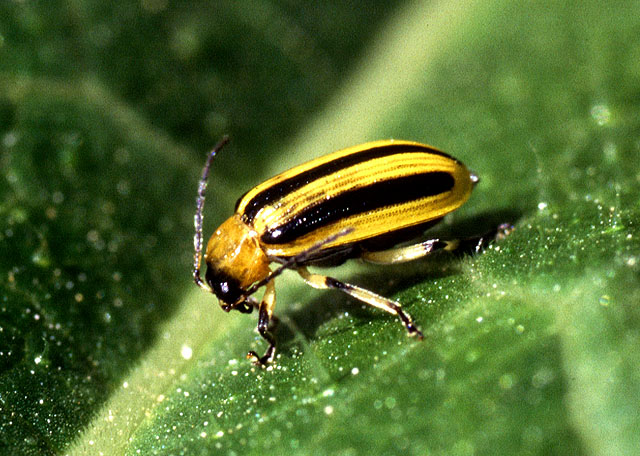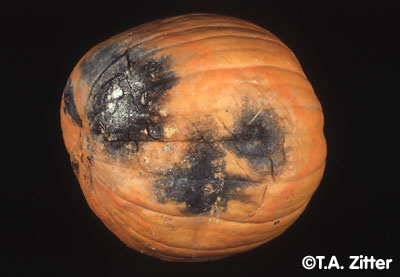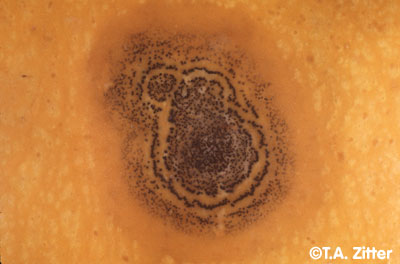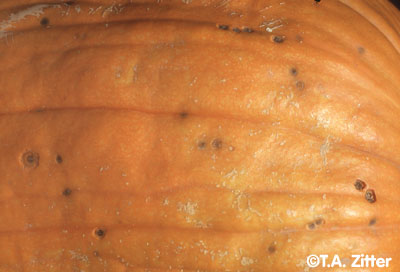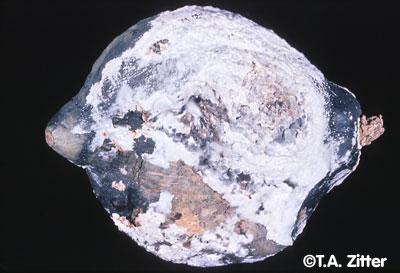Cucurbita maxima
Major
- Home
- Classification Information
- Origin/Habitat
- Adaptation
- Nutrition
- Life Cycle/Reproduction
- Interactions with other species
- Story of the Jack-o-Lantern
- Other Interesting Facts
- About Me
- References
- MultipleOrganisms.net
Interactions with other species
Insects
The insects can be both beneficial or harmful organisms to pumpkins.
Acalymma vittatum, or striped cucumber beetle, can cause damage to the vine, fruit, and roots of the pumpkin plant. The adults feed on the leaves, blossoms, cotyledons, fruit, and stems, while the larva feed on the roots. As beetles feed near the xylem, fecal matter containing the bacteria Erwinia tracheiphila is deposited in the indentations left after they've fed. The bacteria cause a bacterial wilt.
The squash bug, Anasa tristis, is also a harmful insect to pumpkins. They feed on the leaves of the plant, causing them to wilt. The wilt is caused by the toxic saliva the insects deposits.
Although insects may carry bacteria to the pumpkin, they are also very important factors its life cycle. The honeybee, or Apis mellifera, is one of the many pollinators of the pumpkin. For the most part, any insects attracted to the flowers could be pollinators, including the sometimes harmful cucumber beetle.
Fungus
Didymella bryoniae and Phoma cucurbitacearum form two parasitic relationships with pumpkins, both of which result in black rot (Figure 1). D. bryoniae in the sexual stage and P. cucurbitacearum in the asexual stage affect the fruit when high moisture levels and moderate temperatures are present. Larger pumpkins are more susceptible than smaller ones because they tend to lay on their sides more in moist soils. A brown spot usually forms on the surface of the rind and becomes white with time. Small black spots form in a ring when fruiting bodies of the fungi are produced (Figure 2). Similar black rot-appearing rings are caused by Colletotrichum coccodes. Black rot may be prevented by crop rotation and use of fungicides.
Figure 1. Black rot Figure 2. Black rot showing fruiting bodies
Colletotrichum orbiculare causes another pumpkin disease known as Anthracnose. Again, moderate temperatures and moisture allow this fungus to thrive and affect pumpkins. The disease causes sunken lesions on the ring 2 to 5mm or larger in diameter. With humidity, these small lesions blacken (Figure 3).
Figure 3. Anthracnose lesions
Sclerotinia White Mold is a disease caused by the fungus Sclerotinia sclerotiorum. A white, cotton-like mold appears on the surface of the pumpkin that can spread from fruit to fruit (Figure 4). The decay is fast, and fruits are even more susceptible when grown near beans or cabbage, which are extremely susceptible and easily spread the fungus. Again, crop rotation can help prevent the mold from spreading.
Figure 4. Sclerotinia White Mold
Vertebrates

Deer, squirrels, cattle, goats, pigs, chickens, turkeys, and other vertebrate animals use C. maxima as a source of food. It is a mutualistic interaction because the pumpkin provides the animals with a source of food, and the animals disperse seeds in fecal matter in various areas.
As humans, we, too, use the pumpkins for food, but they also make fantastic decorations for Halloween! Check out how the Jack-o-Lantern came to be here.
